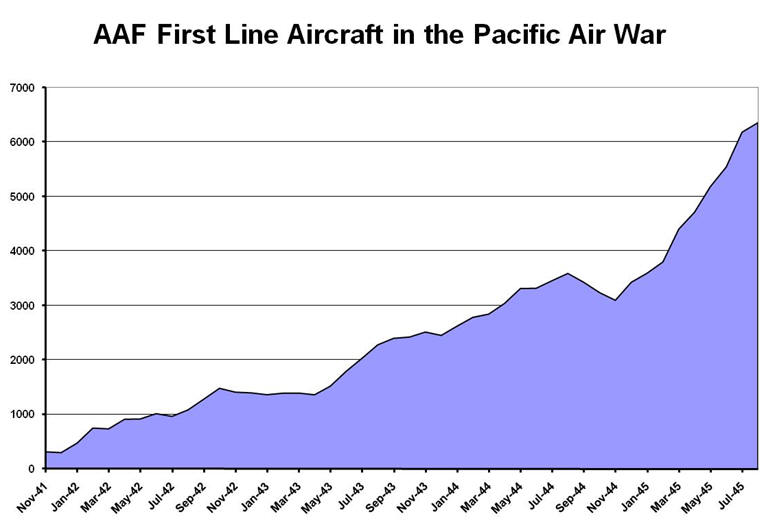 The U.S. Army Air Force was the largest air component in the Pacific
War. Between 1941 and
1945, The AAF in the Pacific grew from less than 325 to more than
6,000 first line aircraft.
These airplanes were assigned to more than 260 squadrons in
six numbered Air Forces.
As the war began the AAF was in the process of deploying its main
strategic bombing force of the time (10 Squadrons of B-17’s) to the
Philippines. The war
ended under the same circumstances, except by 1945 the aircraft were
B-29’s and deployment involved two air forces and 120 B-29 squadrons
being deployed to Okinawa and the Marianas.
Application of Strategic Air
Power failed to deter the Japanese in 1941 but less than four years
later brought about the end of the war.
The U.S. Army Air Force was the largest air component in the Pacific
War. Between 1941 and
1945, The AAF in the Pacific grew from less than 325 to more than
6,000 first line aircraft.
These airplanes were assigned to more than 260 squadrons in
six numbered Air Forces.
As the war began the AAF was in the process of deploying its main
strategic bombing force of the time (10 Squadrons of B-17’s) to the
Philippines. The war
ended under the same circumstances, except by 1945 the aircraft were
B-29’s and deployment involved two air forces and 120 B-29 squadrons
being deployed to Okinawa and the Marianas.
Application of Strategic Air
Power failed to deter the Japanese in 1941 but less than four years
later brought about the end of the war.
The AAF’s equipment evolved over the four year period. P-40s and P-39s of 1942 gradually were replaced by P-38s beginning in 1942, P-47s beginning in 1943, and P-51s beginning in 1944. The initial night fighter was the largely ineffective P-70, but this aircraft was replaced by the P-61 and variants of the P-38.
Initially, the AAF rushed all kinds of bombers; B-17, LB-30, B-24, B-25, B-26, A-20, A-24, to the Pacific in an effort to hold back the Japanese. By 1943 the AAF had standardized on the B-24s, B-25s, and A-20s. By 1945 A-26s were replacing A-20s and B-32s were being tested.
The photo version of the P-38, F-4 or F-5, was the primary photo reconnaissance aircraft. For longer ranged photo missions the AAF used the photo version of the B-24, the F-7. The ultimate expression of long range photo reconnaissance was the inclusion in each of the strategic air forces a squadron of F-13s, the photo version of the B-29. For most of the war tactical reconnaissance was conducted by P-39s and P-40s. By 1945 P-51s and F-6’s had taken over.
Airlift was critical in the Pacific Air War. Initially all kinds of civilian aircraft were put into use. Ultimately the C-47 emerged as the tactical airlift workhorse. It was supplemented by the C-46 later in the war. These aircraft were supplemented on Strategic Airlift missions by the C-87, the cargo version of the B-24, and by the C-54. Both had four engines and long range cargo capability.
Tactical doctrine matured through the war to include effective day and night air defense, bomber escort, close air support of infantry, sea control, and interdiction.
By 1943 a numbered air force was associated with each Pacific Area:
- 5th Air Force assigned to the South West Pacific Area
- 7th Air Force assigned to the Central Pacific Area
- 11th Air Force assigned to the North Pacific Area
- 13th Air Force assigned to the South Pacific Area
In June of 1944 the 5th and 13th Air Forces were placed under a new, higher Air Force Headquarters the Far East Air Force. The 7th Air Force was placed in this command in July 1945.
Initially, Pacific based B-29 units were under command of the XXI Bomber command, an element of the 20th Air Force based in Washington, DC. By July 1945 a Strategic Air Force Headquarters was organized under General Spatz , who had been redeployed from Europe. He had command of two AAF numbered air Forces. He also would have commanded the Commonwealth “Tiger” Force had it been deployed to Okinawa.
- 20th Air Force assigned to the Marianas
- 8th Air Force redeploying from England to Okinawa, reequipped with B-29 and commanded by Lt. General Doolittle
George Kenney and Curtis LeMay were the Air Force generals that most influenced the outcome of the Pacific Air War. Both exercised this influence through leadership and tactical innovations.
In 1942 and 1943 General Kenny gave the AAF effective sea control tactics. He also introduced long range fighter escort equipment and tactics months before the AAF adopted similar tactics in Europe. General Kenny served as Allied Air Commander under General MacArthur and head of the Far East Air Force.
Major General LeMay realized that Japan was particularly vulnerable to low level, night, fire raids. As commander of the XXI Bomber Command in 1945 he burned out the cities of Japan.